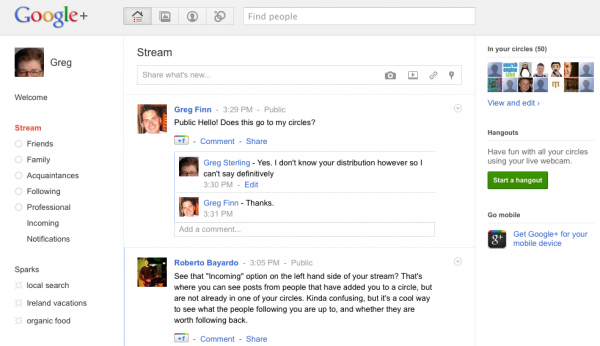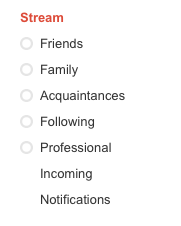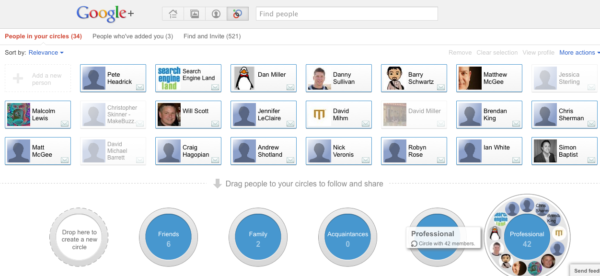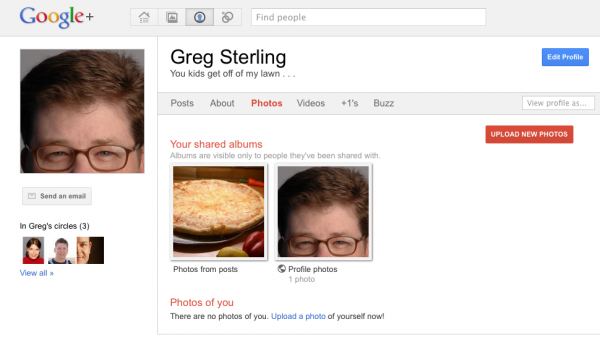First Look: “Hands On” With Google+
I’ve been manically playing with Google Plus for about an hour now and, while there is disagreement here among the editorial team at Search Engine Land, I give it a qualified “thumbs up.” At first glance many people will dismiss Google Plus as redundant and derivative of Twitter and Facebook, in particular. This was also […]
 I’ve been manically playing with Google Plus for about an hour now and, while there is disagreement here among the editorial team at Search Engine Land, I give it a qualified “thumbs up.”
I’ve been manically playing with Google Plus for about an hour now and, while there is disagreement here among the editorial team at Search Engine Land, I give it a qualified “thumbs up.”
At first glance many people will dismiss Google Plus as redundant and derivative of Twitter and Facebook, in particular. This was also true of the ill-fated Buzz. But this is a much better and more thoughtfully designed product than Buzz.
Familiar UI but Takes Getting Used To
Accordingly the interface is familiar and relatively intuitive but Google Plus still takes some “getting used to.” Some have already criticized Google Plus as a “reactive” product, simply mimicking Facebook with some tweaks.
Google’s radically different product Google Wave crashed and burned because people didn’t really know what it was or how to use it. It was too scary unfamiliar. Plus plays it safer and is less of a departure from the known universe of social media tools (Facebook, Twitter) than Wave was from email, for example.
I’m not going to attempt a comprehensive feature tour. No doubt there will be many articles in the days that follow on every conceivable aspect of Google Plus. Instead I’m going to express some initial “hands on” observations about the product and user experience.
Better than Buzz
As I said, out of the gate it’s a much stronger product than Buzz ever was/is (Buzz is integrated as a tab here.) Google has learned the painful lesson of Buzz and has taken enormous pains to attend to privacy in the overall design and experience of the product.
It’s very easy to add people and organize them into standard or customized groups (see list below). This is one of the things that immediately impressed me, as well as the attention to privacy and selective sharing. There’s lots of control over who sees what updates, etc. You’re also able filter all messages and updates by category to see only those from “friends” or “professional” contacts. On the Plus homepage you can click down the list and get selective views from each of your groups:
Users can create and manage groups (“Circles”) very easily once you understand how Plus is organized. This takes relatively little time.
There are four basic navigational buttons: Home (stream/update feed), Photos, Profile and Circles (groups).
Hangout Could Be the Breakout
From the homepage you can also initiate chats through Google Talk or video chat (up to 10) via “Hangout.”
Ultimately Hangout may be the feature that gets the most attention and draws users. It’s directly competitive with a number of video chat products but most directly Skype, now a Microsoft property.
Hangout doesn’t work in mobile, but I would expect that eventually a mobile capability will be added.
Today I didn’t actually use Hangout with anyone to see how easily or well it works. I’ll test Hangout in the coming days. I imagine, however, that it’s fairly easy to use. Google has been testing all the features internally for some time.
Mobile May Help Sell It
Google has created a native Android app and an HTML5 “web app” for iOS. The Android app is far superior (probably by design) to the iOS offering.
The Apple version of Google Plus doesn’t give users access to the full range of features of the product. However the Android app gives you almost all the features of the PC experience, with the addition of group chat (“Huddle”) and “instant upload.”
Instant upload allows you to quickly access pictures online or upload images and video from your phone. In testing out the feature I didn’t find it easier than uploading images to Facebook however. Still it’s helpful to have another quick way to get pictures or video off the phone.
The persistent and somewhat annoying Android notifications will remind you that Plus is there every time someone in your Circles takes some sort of action.
Group chat feature “Huddle” may prove a hit with those inclined to group text. There are numerous group texting (or messaging) apps in the market and it seems a pretty volatile segment that Apple, Google or Facebook or Skype (perhaps) could eventually dominate.
Now, Will They Come?
Google’s “field test” invitation-only rollout echoes the selective Gmail and Google Wave rollouts. It’s also partly to avoid any PR headaches such as what happened with Buzz. But I would imagine there’s also a marketing calculation to create scarcity intentionally.
By hoarding invites Google will create a certain amount of pent-up demand for the service. Once Google does open it up the ease with which users can add those from their address books or other email systems could enable relatively fast adoption.
Google says Plus isn’t a Facebook competitor. “Pay no attention to the man behind the curtain.”
Whether or not it’s intended as a Facebook competitor, it’s definitely not a “Facebook killer.” However its privacy controls and selective group communication tools will appeal to some turned off by Facebook’s aggressive pushing of privacy boundaries and buttons.
As I mentioned, in the near term, many contented Facebook and Twitter users will see no need for Plus. But over time selected features could draw users in: Hangout, Huddle, Instant Upload. And if Google can develop traction with a core fan base they will probably pull in their networks. Another tool: any update/message can be sent (automatically via email) to non-Plus users who are part of one’s Circles. Enough of these emails and people may decide “what the hell.”
But how patient is Google going to be with Plus (it wasn’t very patient with Wave) and how much is it going to promote or advertise the product to consumers? These are key questions that will determine whether Plus becomes a kind of second “hub” or touch-point for Google products (search being the first) or whether, after the initial frenzy dies down, it languishes as have several of Google’s past social experiments.
Related Entries
Contributing authors are invited to create content for Search Engine Land and are chosen for their expertise and contribution to the search community. Our contributors work under the oversight of the editorial staff and contributions are checked for quality and relevance to our readers. The opinions they express are their own.
Related stories





